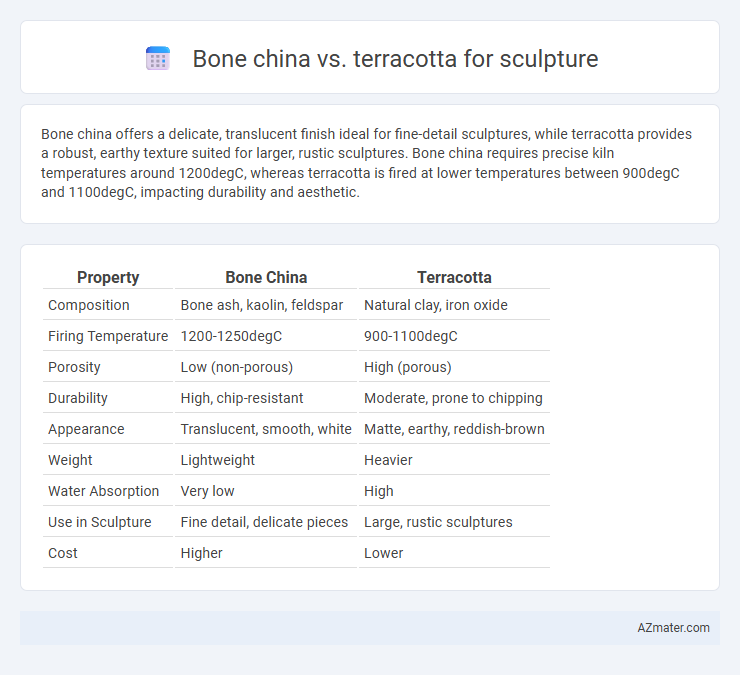Bone china offers a delicate, translucent finish ideal for fine-detail sculptures, while terracotta provides a robust, earthy texture suited for larger, rustic sculptures. Bone china requires precise kiln temperatures around 1200degC, whereas terracotta is fired at lower temperatures between 900degC and 1100degC, impacting durability and aesthetic.
Table of Comparison
| Property | Bone China | Terracotta |
|---|---|---|
| Composition | Bone ash, kaolin, feldspar | Natural clay, iron oxide |
| Firing Temperature | 1200-1250degC | 900-1100degC |
| Porosity | Low (non-porous) | High (porous) |
| Durability | High, chip-resistant | Moderate, prone to chipping |
| Appearance | Translucent, smooth, white | Matte, earthy, reddish-brown |
| Weight | Lightweight | Heavier |
| Water Absorption | Very low | High |
| Use in Sculpture | Fine detail, delicate pieces | Large, rustic sculptures |
| Cost | Higher | Lower |
Introduction to Bone China and Terracotta
Bone china is a refined type of porcelain known for its high strength, translucency, and white color, making it ideal for delicate, intricate sculptures with smooth finishes. Terracotta, a porous clay-based ceramic, has a warm, earthy tone and offers durability and versatility, often used for larger, rustic sculptures or garden artworks. Artists choose bone china for fine detail and elegance, while terracotta suits robust, textured pieces with a natural aesthetic.
Historical Background and Origins
Bone china originated in 18th-century England, combining bone ash, feldspathic material, and kaolin to create a durable, translucent ceramic favored for delicate sculptures and fine detailing. Terracotta, dating back to ancient civilizations such as Mesopotamia and the Indus Valley, consists of fired clay that offers a porous, earthy texture ideal for larger, rustic sculptures and architectural forms. Both materials reflect distinct cultural heritages and artistic techniques essential to the evolution of sculpture craftsmanship worldwide.
Material Composition: Bone China vs Terracotta
Bone china is a type of porcelain composed primarily of bone ash, feldspathic material, and kaolin, offering a unique combination of strength, translucency, and whiteness ideal for intricate sculpture details. Terracotta, made from natural clay fired at lower temperatures, features a porous, earthy texture with warm reddish-brown tones, prized for its rustic and organic aesthetic in sculpture. The key difference in material composition influences durability, finish, and suitability--bone china provides a delicate, refined surface resistant to chipping, while terracotta is more porous and susceptible to weathering but valued for its tactile and historical character.
Sculpting Techniques for Both Materials
Bone china offers a smooth, fine texture ideal for detailed and intricate sculpting techniques such as carving and delicate modeling, allowing for precise, refined finishes. Terracotta, with its coarse and porous nature, supports robust hand-building methods like coiling and slab construction, suitable for larger, more expressive sculptures with a natural, earthy aesthetic. Mastery of firing temperatures is crucial for both materials: bone china requires controlled kiln settings to prevent warping, while terracotta benefits from lower firing temperatures to enhance its durability and surface texture.
Strength and Durability Comparison
Bone china offers superior strength and durability compared to terracotta due to its high levels of vitrification and density, making it less prone to chipping and breaking. Terracotta, being porous and fired at lower temperatures, is more susceptible to cracking and erosion over time, especially in moist environments. For sculptures requiring long-lasting resilience and fine detail preservation, bone china remains the preferred material over terracotta.
Surface Finish and Aesthetic Qualities
Bone china sculptures exhibit a smooth, translucent surface finish that enhances intricate details and offers a refined, elegant aesthetic with a glossy sheen. Terracotta, by contrast, has a porous, matte finish that provides a warm, earthy texture and rustic charm, emphasizing natural variations in color and surface roughness. The high density and vitrification of bone china contribute to its durability and delicate appearance, whereas terracotta's breathable, coarse surface lends itself to a raw, organic visual impact in sculptural art.
Suitability for Detailed Sculpting
Bone china offers exceptional suitability for detailed sculpting due to its fine, smooth texture and high level of translucency, allowing artists to achieve intricate designs with sharp precision. Terracotta, while more porous and coarser, excels in creating rustic, textured sculptures but is less ideal for capturing minute details because of its grainier surface and lower firing temperature. Sculptors seeking delicate, refined features typically prefer bone china for its ability to hold intricate patterns and maintain strength after firing.
Firing Process and Temperature Differences
Bone china sculptures require a high firing temperature, typically around 1200-1300degC, allowing for a dense, translucent finish due to the high calcium phosphate content from bone ash. Terracotta sculptures are fired at lower temperatures, usually between 900-1000degC, resulting in a porous, matte finish because of its iron-rich clay composition. These temperature differences significantly affect durability, texture, and aesthetic qualities, with bone china offering a refined elegance and terracotta providing a rustic, earthy appeal.
Cost and Accessibility of Materials
Bone china offers a high-end, refined finish for sculptures but comes with a higher cost due to its specialized porcelain composition and the need for precise firing techniques, making it less accessible for many artists. Terracotta is significantly more affordable and widely available, composed primarily of natural clay, which offers ease of use and accessibility for both beginners and professionals. The material choice impacts overall project budget and accessibility, with terracotta favored for cost efficiency and bone china chosen for premium quality and delicate detailing.
Environmental Impact and Sustainability
Bone china features a lower carbon footprint due to its efficient kiln firing at high temperatures and minimal raw material waste, making it more eco-friendly for sculpture production. Terracotta, while made from natural clay, requires longer firing times and releases more CO2, contributing to higher environmental impact. Both materials are biodegradable, but bone china's durability extends the lifecycle of sculptures, promoting sustainability through longevity.

Infographic: Bone china vs Terracotta for Sculpture
 azmater.com
azmater.com